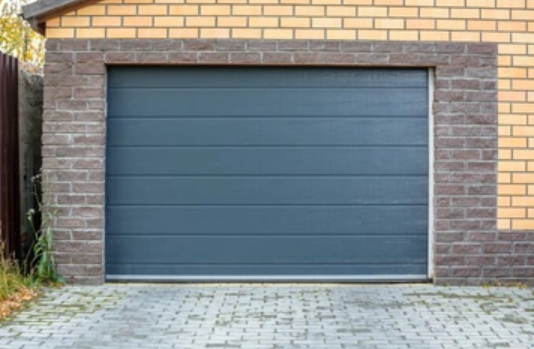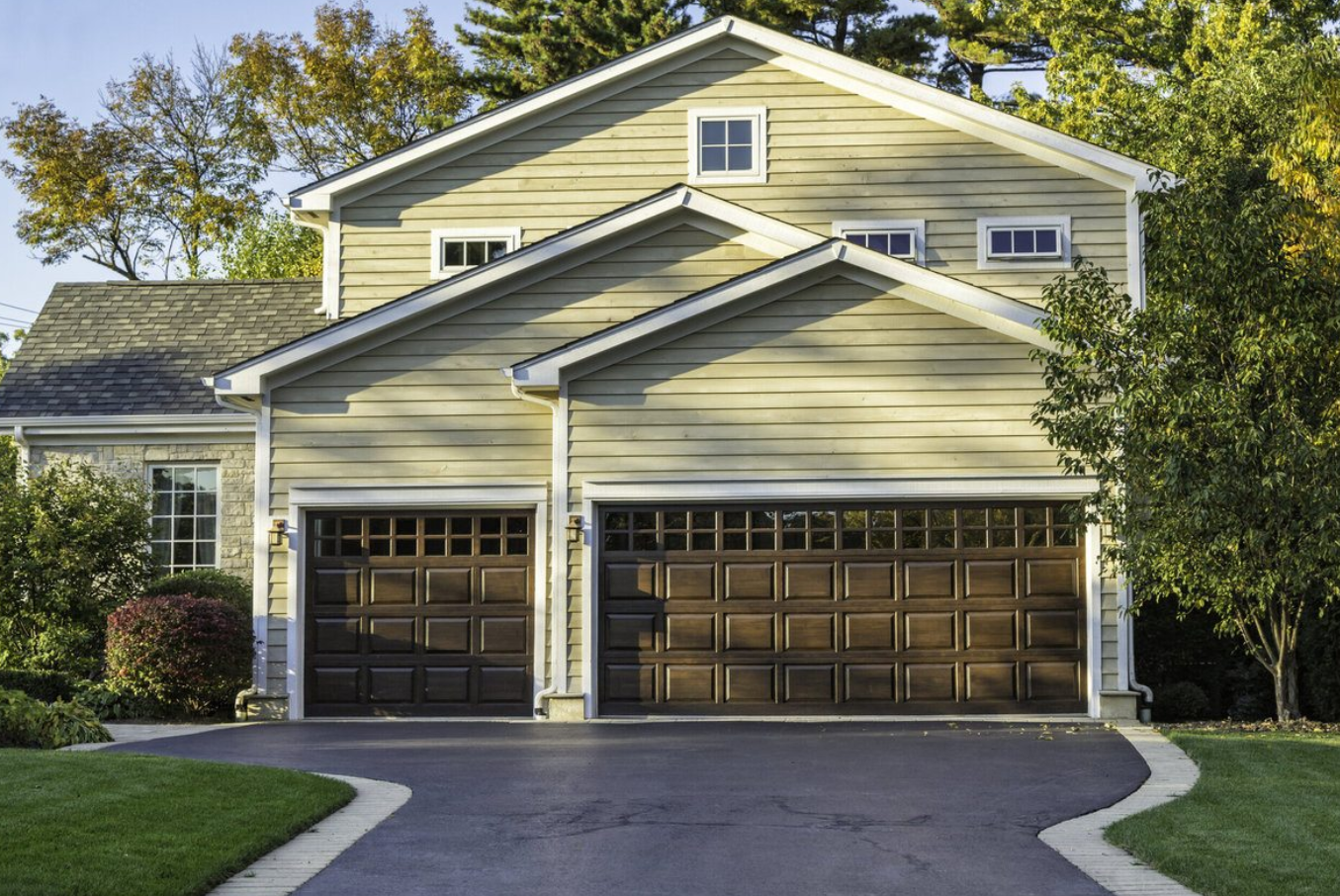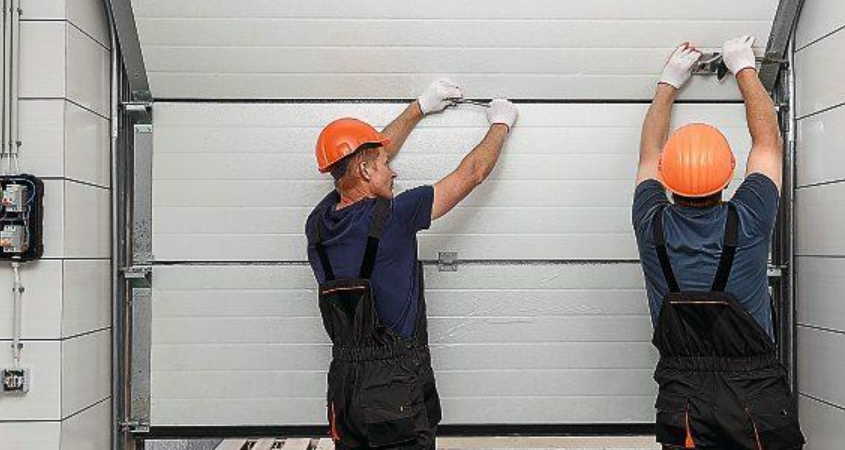Garage doors play a crucial role in protecting our vehicles and belongings while also enhancing the aesthetic appeal of our homes. They provide security, insulation, and convenience, making them an essential part of modern residential architecture. Choosing the right garage door can not only improve your home’s curb appeal but also add value to your property.
I understand the critical role a garage door plays in your home. It’s not just about security and function, but also about enhancing your home’s curb appeal. This guide provides an overview of the most common types of garage doors available today, covering their designs, strengths, and potential weaknesses.
With this information, you’ll be well-equipped to make a knowledgeable decision on a garage door that meets your needs and complements your home’s architecture. Let’s explore together.
Roll-up Garage Door
Roll-up garage doors, also known as coiling doors, are made from horizontal slats of steel, aluminum, or other materials that are connected together to form a continuous curtain. When the door is opened, the slats roll or coil around a drum located above the door opening. This design is commonly found in commercial and industrial settings but has gained popularity in residential applications as well.

Advantages of Roll-up Garage Door
- Durability
Roll-up garage doors are known for their robust construction, making them a durable option that can withstand harsh weather conditions and heavy usage. The materials used in their construction, such as steel and aluminum, also contribute to their longevity.
-
Minimal space requirements
Due to their design, roll-up garage doors do not require additional space on either side of the door, and they do not swing outwards like other door types. This makes them an ideal choice for homes with limited space or narrow driveways.

Disadvantages of Roll-up Garage Door
-
Limited insulation
Roll-up garage doors generally offer less insulation compared to other types of garage doors, such as sectional doors. This can result in higher energy costs if your garage is attached to your home, and may affect the overall comfort of the space.
-
Maintenance requirements
Roll-up garage doors have more moving parts, which can increase the need for regular maintenance. Lubrication of the moving components and proper alignment of the tracks are essential to ensure smooth operation and prevent potential issues.
Sectional Garage Doors
Sectional garage doors are composed of several horizontal panels or sections that are hinged together, allowing the door to operate smoothly. They are designed to move vertically along tracks and then curve into a horizontal position overhead, which makes them a popular choice for many homeowners. These doors can be made from various materials, including steel, aluminum, wood, and fiberglass, and are available in numerous colors, finishes, and styles.

Advantages of Sectional Garage Doors
-
Space-saving
Sectional garage doors are an excellent choice for homeowners with limited driveway space, as they open vertically without swinging outwards. This feature allows you to park your vehicle close to the door without obstructing its operation.
-
Security
These garage doors are known for their sturdy construction and secure locking systems, which provide a high level of security against intruders.
-
Insulation
Many sectional garage doors come with built-in insulation, improving the energy efficiency of your home and helping to maintain a comfortable temperature inside the garage.

Disadvantages of Sectional Garage Doors
-
Installation complexity
Sectional garage doors often require professional installation due to their complex mechanism and multiple components. This can result in higher initial costs compared to other garage door types.
-
Cost
While sectional garage doors offer many benefits, they can be more expensive than some other garage door options. The cost will vary depending on the materials used, size, and additional features such as insulation and custom finishes.
Side-Hinged Garage Doors
Side-hinged garage doors, also known as swing-out garage doors, consist of two panels that are attached to the garage opening with hinges on either side. These doors open outward, similar to traditional double doors, and can be made from a variety of materials, including wood, steel, and aluminum. Side-hinged garage doors are available in many styles and designs, ranging from classic to contemporary.

Advantages of Side-Hinged Garage Doors
- Traditional appearance
Side-hinged garage doors offer a timeless, classic look that can add charm and character to your home. Their traditional appearance makes them particularly suitable for older or period-style properties.
- Easy maintenance
Due to their straightforward design, side-hinged garage doors typically require less maintenance compared to other garage door types. There are fewer moving parts, which reduces the chances of mechanical failure and makes routine maintenance tasks simpler to complete.
Disadvantages of Side-Hinged Garage Doors
-
Space consumption
Because side-hinged garage doors swing outward, they require additional clearance in front of the garage. This can be a disadvantage for homes with limited driveway space or in situations where it’s essential to park vehicles close to the door.
-
Less security
Side-hinged garage doors may not provide the same level of security as other types of garage doors, such as sectional or roll-up doors. The design of the locking system and the materials used can impact the door’s overall security, so it’s important to consider these factors when choosing a side-hinged garage door for your home.
Tilt-Up/Up-and-Over Garage Doors
Tilt-up or up-and-over garage doors consist of a single solid panel that pivots on hinges or arms located at the sides of the door opening. When opened, the door tilts outward and upward, sliding into a horizontal position parallel to the garage ceiling. These doors can be constructed from a variety of materials, including wood, steel, aluminum, and fiberglass. There are two main types of tilt-up garage doors: canopy and retractable.
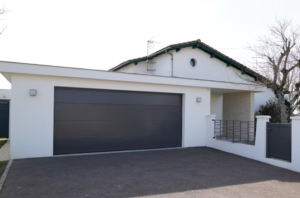
Advantages of Tilt-Up/Up-and-Over Garage Doors
- Cost-effective
Tilt-up garage doors are generally more affordable compared to other types of garage doors, such as sectional or roll-up doors. Their simple design and construction make them a budget-friendly option for many homeowners.
-
Easy installation
Due to their straightforward design, tilt-up garage doors are typically easier to install compared to other garage door types. This can save time and reduce installation costs, especially if you opt for a DIY installation.
Disadvantages of Tilt-Up/Up-and-Over Garage Doors
-
Space requirements
Tilt-up garage doors require additional clearance in front of the garage, as they swing outward before sliding into the overhead position. This can be a disadvantage for homes with limited driveway space or when vehicles need to be parked close to the door.
-
Manual operation
While some tilt-up garage doors can be equipped with automatic openers, many models are designed for manual operation. This may be a drawback for individuals who prefer the convenience of an automatic garage door opener.
Sliding Garage Doors
Sliding garage doors consist of one or more horizontal panels that slide to the side along a track when opened. The panels are usually mounted on rollers, allowing for smooth and effortless operation. These doors can be made from various materials, including wood, steel, aluminum, and glass. Sliding garage doors can be designed as a single large panel or multiple smaller panels, depending on the desired aesthetic and functional needs.

Advantages of Sliding Garage Doors
-
Space-saving of Sliding Garage Doors
Sliding garage doors do not swing outwards, nor do they require overhead space inside the garage, making them an excellent choice for homes with limited space. They can also be suitable for garages with a low ceiling, where other types of doors might not be feasible.
-
Versatile design options
Sliding garage doors come in a wide range of styles, materials, and finishes, allowing for a high degree of customization. This versatility makes it easy to find a sliding garage door that complements your home’s architecture and design aesthetic.
Disadvantages of Sliding Garage Doors
-
Complex installation
The installation of sliding garage doors can be more complicated than other types of garage doors due to the track and roller system. This typically requires professional installation, which can result in higher initial costs.
-
Maintenance
Sliding garage doors require regular maintenance to ensure smooth operation, including cleaning and lubrication of the tracks and rollers. Additionally, any debris or obstructions in the tracks can impact the door’s performance, making it essential to keep the tracks clean and clear.
Carriage House Garage Doors
Carriage house garage doors, also known as barn-style garage doors, are designed to resemble the appearance of traditional carriage house doors. These doors often feature decorative hardware, windows, and paneling details, giving them a distinctive and elegant look. Carriage house garage doors can be found in various materials, including wood, steel, and fiberglass, and can either swing out like classic carriage house doors or operate on a track system similar to sectional garage doors.
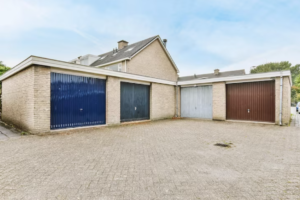
Advantages of Carriage House Garage Doors
-
Aesthetic appeal
Carriage house garage doors are known for their unique and charming appearance, which can significantly enhance your home’s curb appeal. These doors are an excellent choice for homeowners who desire a classic, timeless look that adds character to their property.
-
Customizable design
With a wide variety of materials, finishes, and decorative options available, carriage house garage doors can be customized to match your home’s style and design preferences. This allows for a high degree of personalization, ensuring your garage door complements your home’s architecture and aesthetic.
Disadvantages of Carriage House Garage Doors
-
Higher cost
Carriage house garage doors can be more expensive than other garage door types, particularly if you opt for custom designs and high-end materials. The cost will vary depending on the materials used, size, and additional features such as windows and decorative hardware.
-
Possible maintenance requirements
Depending on the materials used, carriage house garage doors may require more maintenance than other types of garage doors. For example, wooden doors typically need regular painting or staining to maintain their appearance and protect them from the elements. Additionally, the decorative hardware and hinges may require periodic lubrication and inspection to ensure smooth operation.
Below table provides a quick comparison of the key advantages and potential disadvantages associated with the most common types of garage doors.
| Garage Door Type | Key Advantages | Potential Disadvantages |
|---|---|---|
| Roll-up Garage Door | Durability, Space-efficient | Limited insulation, Higher maintenance requirements |
| Sectional Garage Doors | Space-saving, Good security, Insulation | Complex installation, Higher cost |
| Side-Hinged Garage Doors | Traditional aesthetic, Easy maintenance | Requires more space, Less security |
| Tilt-Up/Up-and-Over Garage Doors | Cost-effective, Easy installation | Requires more space, Typically manual operation |
| Sliding Garage Doors | Space-saving, Versatile design options | Complex installation, Maintenance requirements |
| Carriage House Garage Doors | Aesthetic appeal, Customizable design | Higher cost, Possible higher maintenance requirements |
Material Options for Garage Doors
Choosing the right material for your garage door is a crucial decision that affects its durability, maintenance, insulation, and aesthetic appeal. Each material option comes with its unique set of advantages and disadvantages. To help you make an informed decision, the following table provides a comparison of the most common garage door materials—wood, steel, aluminum, fiberglass, and vinyl—highlighting their respective pros and cons.
| Material | Pros | Cons |
|---|---|---|
| Wood | Natural beauty and warmth, Highly customizable with various designs, stains, and paint colors, Good insulating properties | Susceptible to warping, cracking, and rot due to weather exposure, Requires regular maintenance, including painting or staining, Heavier and may require a stronger opener |
| Steel | Strong and durable, providing excellent security, Low maintenance, Available in various styles, colors, and insulation options | Can be prone to rust and dents if not properly maintained, Less insulation compared to other materials |
| Aluminum | Lightweight, making it suitable for larger doors or less powerful openers, Rust-resistant and low maintenance, Available in various styles and colors | Less insulating than other materials, Can be prone to denting |
| Fiberglass | Resistant to rust, rot, and warping, Lightweight and durable, Available in various colors and styles, including wood-like finishes | Can crack or break in very cold climates, Offers less insulation compared to other materials |
| Vinyl | Low maintenance and resistant to dents, scratches, and fading, Can mimic the appearance of wood or other materials, Resistant to rot, rust, and insect damage | Limited customization options compared to other materials, May not provide the same le |
Recap of the common types of garage doors
Throughout this article, we have discussed the most common types of garage doors, including sectional, roll-up, side-hinged, tilt-up/up-and-over, sliding, and carriage house garage doors. Each type has its own unique set of advantages and disadvantages, catering to different preferences, functionalities, and aesthetic requirements. Additionally, various material options like wood, steel, aluminum, fiberglass, and vinyl can further influence the performance, appearance, and maintenance requirements of your garage door.
Importance of choosing the right garage door for individual needs and preferences
Selecting the right garage door for your home is crucial, as it not only provides security and protection for your vehicles and belongings but also contributes significantly to your property’s curb appeal. By considering factors such as available space, functionality, design, insulation, and maintenance requirements, you can make an informed decision that caters to your individual needs and preferences. The right garage door will not only enhance your home’s aesthetic but also add value to your property, making it a worthwhile investment.

